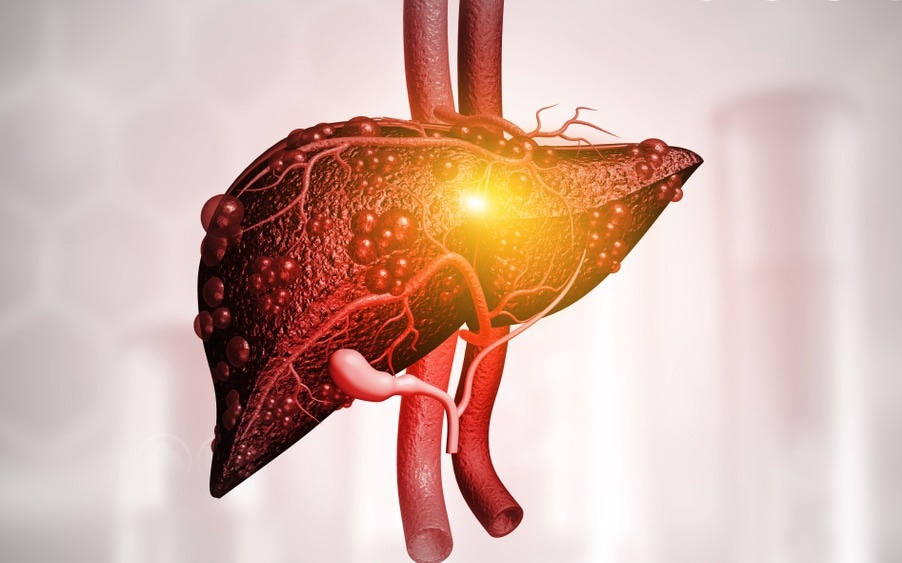The global outbreak of the severe acute respiratory syndrome coronavirus 2 (SARS-CoV-2), which subsequently led to the coronavirus disease-2019 (COVID-19) pandemic, has claimed more than 6.5 million lives worldwide.
Although SARS-CoV-2 is a respiratory virus, hepatic malfunctions have been reported in almost 50% of infected patients. Manifestation of chronic liver disease (CLD) has been a common occurrence in severely infected COVID-19 patients who require hospitalization.
 Study: Liver and Biliary Tract Disease in Patients with COVID-19 Infection. Image Credit: Explode / Shutterstock.com
Study: Liver and Biliary Tract Disease in Patients with COVID-19 Infection. Image Credit: Explode / Shutterstock.com
A higher mortality rate has been associated with severely infected COVID-19 patients with cirrhosis. A recent Gastroenterology Clinics of North study summarizes the clinical outcomes of COVID-19 patients with CLD.
Prevalence of liver dysfunction in COVID-19
Elevated liver enzyme levels were observed in about 83% of COVID-19 patients who required hospitalization. Among all liver enzymes, an increased level of aspartate transaminase (AST) was most commonly observed in this group of patients.
Increased bilirubin, glutamyl transferase (GGT), and alkaline phosphatase (ALP) levels were reported in 3-23%, 13-54%, and 1-22% of COVID-19 patients, respectively. Importantly, one of the key markers of COVID-19 severity is hypoalbuminemia.
The pattern of liver injury linked to SARS-CoV-2 infection was primarily hepatocellular rather than cholestatic. In the early phase of infection, a mild elevation in AST and ALT was observed. In most cases, AST levels were higher than ALT, with these levels significantly increased in accordance with disease severity.
In most cases, hepatic biochemical test anomalies returned to normal levels within two to three weeks without requiring any specific treatment. COVID-19 patients with elevated AST and ALT levels were associated with higher mortality.
Pregnant women with COVID-19 exhibited high AST and ALT levels, thus demonstrating the importance of monitoring this group for hepatic injuries. Individuals who had a history of advanced liver disease, especially cirrhosis, were at a greater risk of mortality after SARS-CoV-2 infection.
Pathogenesis of liver injury in COVID-19
Several potential mechanisms associated with liver injury in COVID-19 patients have been reported. Liver histology at autopsy have reported the presence of microvesicular/macrovesicular steatosis, focal necrosis, lobular necroinflammation, portal inflammation, and porto-venous/sinusoidal microthrombosis.
SARS-CoV-2 infects the host cell by binding to angiotensin-converting enzyme 2 (ACE2) receptors. These receptors are found in hepatocytes and cholangiocytes, thus making the liver a potential target for infection.
Additionally, SARS-CoV-2 directly targets liver cells and damages bile duct epithelial cells. Autopsy samples have also suggested SARS-CoV-2 liver tropism.
In severely infected COVID-19 patients, the host immune system releases an excessive amount of inflammatory mediators, such as interleukin 6 (IL-6), IL-10, IL-2, and interferon γ (IFN γ), thus causing cytokine storms, which can lead to severe hepatic dysfunction. Significant upregulation of type I and II IFN responses has also been observed in severely infected COVID-19 patients.
Some of the therapeutic agents that are used to treat SARS-CoV-2 infection, such as immunomodulators, corticosteroids, antibiotics, and antiviral agents, can cause liver injury to varying degrees. For example, lopinavir/ritonavir increases the risk of liver injury by four-times.
Additionally, remdesivir, which is a nucleoside analog inhibitor of viral ribonucleic acid (RNA) polymerase, was found to increase hepatic biochemical levels by 23%. COVID-19 patients treated with tocilizumab also exhibited an elevation of transaminase level.
Clinical outcomes of COVID-19 patients with pre-existing CLD
Several multicenter and large-scale cohort studies have revealed that CLD was associated with significantly higher mortality, particularly among patients with cirrhosis. Retrospective cohort studies based in Hong Kong and China revealed that hepatitis B virus (HBV) infection was not associated with mortality from COVID-19.
Autoimmune hepatitis (AIH) is a rare outcome following COVID-19. Data from multiple studies have shown that AIH patients were not at an increased risk of adverse clinical outcomes post-SARS-CoV-2 infection. Similarly, alcohol-related liver disease (ALD) was reported to be an independent risk factor for mortality in CLD patients with COVID-19.
Liver transplant patients are at a high risk of contracting COVID-19; however, their mortality rate was significantly lower and matched the outcomes of the general population.
Impact of COVID-19 vaccines on CLD and liver transplant patients
Adult CLD patients, particularly those with cirrhosis and liver-transplant recipients, were strongly recommended to receive the COVID-19 vaccine. As compared to unvaccinated CLD patients, vaccinated patients were associated with a 64.8% reduced risk of SARS-CoV-2 infection. Vaccinated CLD patients were also protected from severe infection.
Some cirrhosis patients experienced breakthrough COVID-19 infection after full or partial vaccination. Nevertheless, these infections were associated with reduced mortality as compared to unvaccinated CLD patients.
Most CLD patients and liver transplant recipients exhibit favorable clinical outcomes post-COVID-19 vaccination. Lower serological response to immunization was found in older aged patients and those who were under antimetabolite drugs and B cell-depleting therapies.